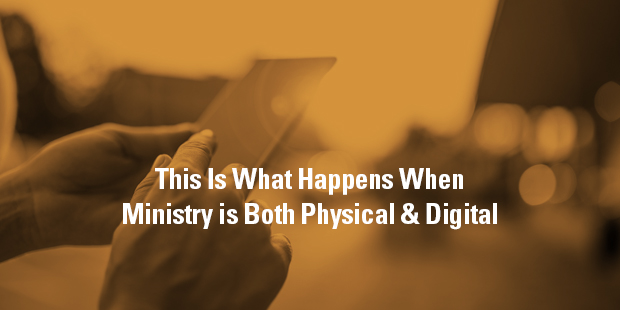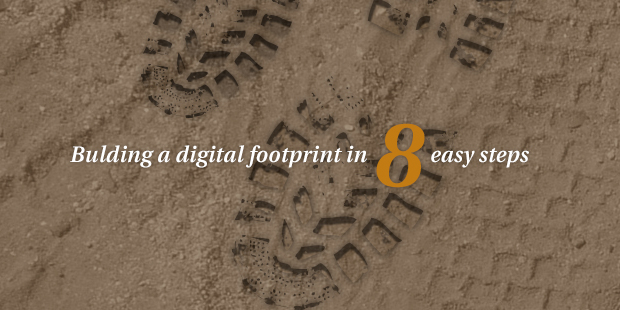
This Is What Happens When Ministry is Both Physical & Digital
There’s a new, and important, word: “phygital.”
It reflects the growing necessity for the seamless flow between the physical and the digital. As an article on Bizcommunity put it, in relation to the retail world:
Innovative phygital business models, where bricks and mortar and digital seamlessly integrate, are popping up across the globe. But the best phygital experiences still remain aligned with old-school sales strategies: customer attraction, retention, engagement, experiences, loyalty and the brand itself. The factors that keep shifting are shopping behaviour and new technology. The upshot is: to keep in the retail game, phygital is the way to go and it’s currently an adapt or die situation.
And here are the six ways it suggests that “adapt or die” applies:
1. The agile store.
The concept of the role of a physical shop has changed. Whereas before a storefront used to be a part of the shopper psyche there are now young customers who have no knowledge of physical stores dominating the landscape. Nils Van Dam of Duval Union Consulting estimates that between 30—40% of supermarkets will shut their doors within the next decade.
2. Retail business model disruption.
Never seen or experienced before phygital stores are being built, the biggest ones being Amazon and Alibaba. These mega-online players are laying new foundations with bricks and mortar shops—Wholefoods and Hema respectively. The rule of thumb seems to be: whatever bases you’re not covering, cover. Another thing to note about disruption is that agility and adoption are different in terms of what product you sell. According to PWC, in a category such as fashion, 43% of consumers already consider themselves to be omnichannel shoppers, buying both offline and online.
3. Different strokes for different folks.
Quite surprisingly, another reason for bricks and mortar may be Gen Z. Not because they love shopping malls but because they demand that every option is available to them. Seventy-five percent of Gen-Zers surveyed by Newsroom Synchrony say they prefer shopping in stores with engaging experiences, while 45% say the experience of buying something is as important as the product itself. Another interesting fact about Gen Z is that if they have a product in their shopping cart while shopping online, they expect to this to be seamlessly integrated into their in-store shopping experience.
4. Covering all bases.
Agile retailers are upping the ante with online and in-store technology. The more common in-store phygital tech includes self-scanning, digital signage tablets and smart tags. Other innovations being tested are things like AR-powered virtual demos, smart mirror beacons, personal in-store digital avatars, face-detection software that can guess a shoppers’ gender and age, as well as interactive fitting rooms with a touch screen kiosk.
5. Uber-experiences.
A bricks and mortar store should look to incorporate whatever the “new fashion” is—be it cooking workshops or yoga. For example, Green Swan the owners of Intertoys, plans to rent out toys for children’s parties. And for the ultimate in-store trend, see the 185-year-old “most beautiful department store” in Zürich—Jelmoli. This old-school bricks and mortar retailer has ten large and small restaurants where they can grill your steak for 90 seconds at 800 degrees.
6. The human role.
Keeping it real and human with bricks and mortar is particularly relevant… [for this] fascinating demographic of shoppers who, on the one hand, consider a trip to the mall a memorable family experience and on the other, … shop “off the radar”, buying from spaza shops in townships and rural areas and belonging to stovels. In both instances, the human connection is vital to the shopping experience. Malls may need to up their game on the experiential level and spaza shops should be taken more seriously by mainstream retailers.
This conversation is not simply for the retail world. “Phygitality,” for lack of a better world, is here to stay. It does not represent the elimination of bricks and mortar, but the importance of what we do physically to integrate with what we do digitally. And, ideally, to have the two create a synergy that is more strategic than either alone.
Consider someone who is wanting to explore a particular church. That used to be a strictly physical process—now it is phygital. When invited by a friend, the invitation is often to explore the church digitally through a website or internet stream. If all goes well, from this comes a physical visit.
The implications are vast, but much of the fruit is low-hanging:
-
Your digital presence is now the front door of your church. As such, it must be designed as a front door. Just as in the ’80s churches learned that the weekend service was the front door of the church, and needed to be “opened” in a purposefully sensitive and strategic way for unchurched guests, today we must open the front door of our websites and social media in a way that is inviting and compelling.
-
Previous barriers that you thought were first and foremost in terms of someone exploring your church – such as having a campus in close physical proximity – are largely muted as the initial exploration is digital instead of physical. And if they like what they experience digitally, the physical location is less of a factor for a subsequent physical exploration.
-
Your digital front door must seamlessly integrate with the physical experience of attending, most obviously by having the experience reflect the digital image and promise you projected.
-
Don’t let the digital remain simply a front door—let the phygital nature of your church be manifest in every conceivable way, including how children’s ministry check-in might be handled online, an app that offers ways to be served in terms of additional content or learning in light of that weekend’s message, and so much more. A guest will walk in because of a digital exploration and have their smartphone in hand. Keep the dynamic going in ways that both serve their exploration and foster a culture of assimilation.
-
Your physical experience must also provide what a digital experience cannot. We already know that the digital world is limited in terms of what it can provide in light of a biblically functioning community. But the person exploring your church most likely does not. They should be enticed by the digital, but then, upon experiencing it physically, should be reminded that whatever they streamed on the front end can never take the place of what they experienced on the back end.
We’re all just beginning to scrape the surface of the phygital demand, whether in the retail world or the church world. But make no mistake—the depths are there to be plumbed for enormous kingdom impact.
> Read more from James Emery White

Tags: Digital, James Emery White, Phygital, Physical















